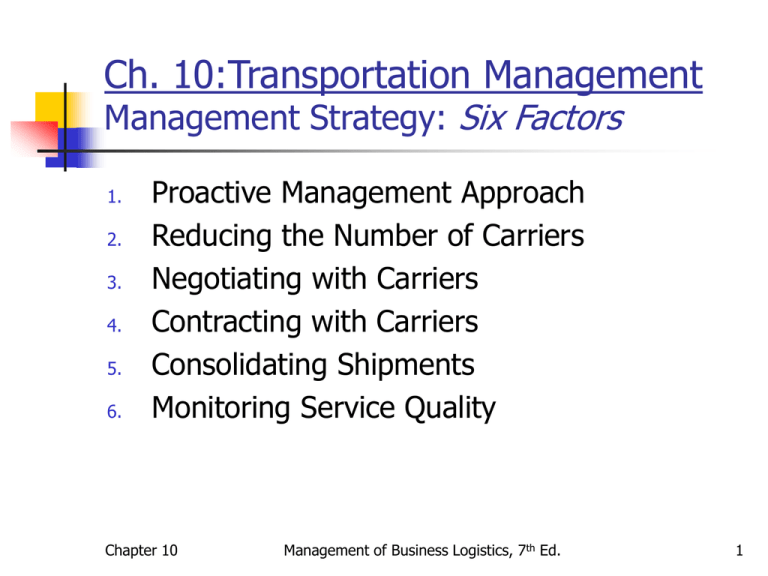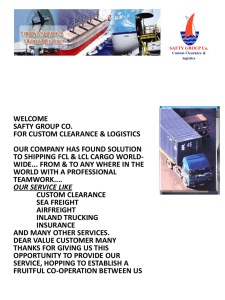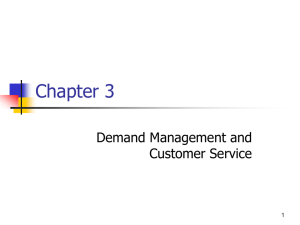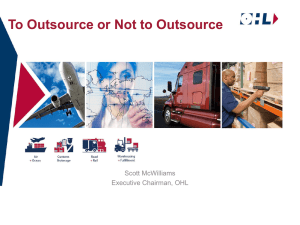Chapter 10 and Appendix 10A
advertisement

Ch. 10:Transportation Management Management Strategy: Six Factors 1. 2. 3. 4. 5. 6. Proactive Management Approach Reducing the Number of Carriers Negotiating with Carriers Contracting with Carriers Consolidating Shipments Monitoring Service Quality Chapter 10 Management of Business Logistics, 7th Ed. 1 Management Strategy: Proactive Management Approach Absence of the regulatory safety net encourages logistics mangers to take a proactive management approach to identify and solve transportation problems. Creativity in problem solving no longer restricted by fixed regulations. Positive attitudes result in using transportation to solve company problems in many functional areas. Chapter 10 Management of Business Logistics, 7th Ed. 2 Management Strategy: Reducing the Number of Carriers Consolidation of freight increases the shippers leverage with the remaining carriers. Being one of a carrier’s largest customers gives the shipper increased negotiating power. Shippers become more important to the carriers as they funnel larger volumes to fewer carriers. Chapter 10 Management of Business Logistics, 7th Ed. 3 Management Strategy: Reducing the Number of Carriers One shipper went from 131 to 14 carriers. Improved service from the remaining carriers decreased its inventory by $30 million. Supply chain strategic alliances are also created through consolidation. However, risk of increased dependency on fewer carriers must be balanced against the benefits. Chapter 10 Management of Business Logistics, 7th Ed. 4 Management Strategy: Negotiating with Carriers With rate negotiation a common outcome of deregulation, consolidation provides the leverage to successfully negotiate more favorable terms of carriage. Elevating the carrier to partnership status in the supply chain philosophy assists in assuring a win-win arrangement between the partners. Chapter 10 Management of Business Logistics, 7th Ed. 5 Management Strategy: Contracting with Carriers Both the Motor Carrier Act of 1980, the Staggers Act of 1980, and the ICC Termination Act of 1995 increased the ability of motor carriers to contract with shippers. As in any contract, special and/or custom services such as JIT can be negotiated. Contracting widely adopted by rail; rates, types of equipment, service levels and minimum quantities are subject to contract terms. Chapter 10 Management of Business Logistics, 7th Ed. 6 Management Strategy: Consolidating Shipments Another benefit of carrier consolidation is that shippers are often rewarded with lower rates as the amount shipped increases. Contracts may be written with minimum shipment size per shipment or for annual cumulative shipment size. Quantity discounts are real savings that the carriers pass on to shippers. Chapter 10 Management of Business Logistics, 7th Ed. 7 Management Strategy: Monitoring Service Quality Product movements that are consistent, timely, and undamaged can be a competitive advantage for a customer. Trade-offs between speed and cost of service must be analyzed to provide the service customers need without paying for speed that might not be required. Examine the Carrier Evaluation Report in Figure 10-1. Chapter 10 Management of Business Logistics, 7th Ed. 8 Federal Regulation: An Overview Federal regulation has been with the transportation industry since the Act to Regulate Commerce in 1887. The genesis of regulation lies in the concept that a transportation system functions in the public interest, similar to a public utility. Individual states were not and still are not permitted to control interstate commerce. Chapter 10 Management of Business Logistics, 7th Ed. 9 Federal Regulation: An Overview In the United States, private industry rather than government provides the transportation services, thus a perceived need for regulation of rates, routes and safety issues empowered federal officials to act in the name of the public good. Reasonable rates, absence of discrimination, and the need to serve all formed the core of the federal regulations. Chapter 10 Management of Business Logistics, 7th Ed. 10 Federal Regulation: An Overview The ICC was formed as a result of the 1887 law and grew in stature until it controlled economic and safety issues for rail, domestic water, freight forwarders, and motor carriers. Air cargo was controlled by the CAB; pipelines by the Federal Energy Regulatory Commission and ocean carriage by the Federal Maritime Commission. Chapter 10 Management of Business Logistics, 7th Ed. 11 Federal Regulation: Deregulation Beginning in 1977, the political and economic climate encouraged economic deregulation, and began with air transportation. The Staggers Act of 1980 reduced regulation for rail and motor transportation. Virtual deregulation occurred with the ICC Termination Act of 1995. Transportation carriers became able to negotiate rates and services with shippers rather than adhere to published rates and services. Chapter 10 Management of Business Logistics, 7th Ed. 12 Federal Regulation: Deregulation Motor and Water Carriers Rate and tariff-filing regulations eliminated except for household and noncontiguous trade. Common carriage concept is eliminated. All carriers may contract with shippers. Antitrust immunity for collective ratemaking. Chapter 10 Management of Business Logistics, 7th Ed. 13 Federal Regulation: Deregulation Air Carriers In 1977, economic regulation of air carriers eliminated. Safety regulation remains in force. Rail Carriers Remains the most regulated of the transportation modes. Complete deregulation over certain types of traffic, piggyback and fresh fruits, for example. Chapter 10 Management of Business Logistics, 7th Ed. 14 Federal Regulation: Deregulation Freight Forwarders and Brokers Both are required to register with the Surface Transportation Board (STB). Brokers must also post a $10,000 bond to ensure payment to the carriers. No economic rate or service controls. Freight Forwarder is considered a carrier and is thus liable for freight damages. Chapter 10 Management of Business Logistics, 7th Ed. 15 Documentation: Domestic Bill of Lading Freight Bill Claims F.O.B. Terms of Sale Chapter 10 Management of Business Logistics, 7th Ed. 16 Documentation: Domestic Bills of Lading Shows title to the goods, name and address of the consignor and consignee. Summarizes the goods in transit and their class rates. Electronic bills now appearing where the carrier and shipper have an established strategic alliance. Chapter 10 Management of Business Logistics, 7th Ed. 17 Documentation: Domestic Bills of Lading Straight Bill Non-negotiable Contains terms of the sale including the time/place of title transfer. Order Bill Negotiable Consignor retains original until bill is paid. Chapter 10 Management of Business Logistics, 7th Ed. 18 Documentation: Domestic Freight Bills Carrier’s invoice for charges for a given shipment. Credit terms are stipulated by the carrier and can vary extensively. Credit may be denied if the charges are worth more than the freight. Bills may also be either prepaid or collect. Freight bills are typically audited internally or externally. Chapter 10 Management of Business Logistics, 7th Ed. 19 Documentation: Domestic Claims A document filed with the carrier to recover monetary losses due to losses, damage, delay or overcharges by the carrier. Typically, claims are filed within 9 months, claimant is notified by receipt within 30 days, and settlement or refusal within 120 days. Claims terms can be stipulated in the contract of carriage agreement and may be atypical. Chapter 10 Management of Business Logistics, 7th Ed. 20 Documentation: Domestic F.O.B. Terms of Sale Determines which party is to pay the freight bill, which party has title to the goods, and which party controls the movement of the goods. F.O.B. origin - buyer pays freight, owns goods once loaded, controls movement of the goods F.O.B. destination - seller pays freight, owns goods until delivered, controls movement of the goods Chapter 10 Management of Business Logistics, 7th Ed. 21 Documentation: International Documentation for international transportation is far more complex than required for domestic transportation. Types of documents vary widely by country. Sales Documents Terms of Sale Transportation Documents Chapter 10 Management of Business Logistics, 7th Ed. 22 Documentation: International Sales Documents Sales contract is the initial document. Letter of Credit may also accompany shipment (guarantees payment). May also use cash and other means of demonstrating an ability to pay for the goods. Chapter 10 Management of Business Logistics, 7th Ed. 23 Documentation: International Terms of Sale AKA “Incoterms”--international credit terms Chapter 10 Terms may include: Export packing costs Inland transportation Export clearance Vehicle loading Transportation costs Insurance Duties Insurances Management of Business Logistics, 7th Ed. 24 Documentation: International Transportation Documents Export Declaration - describes the goods Export License - allows export of goods General license allows export of most goods w/out any special requirements Validation export license for export of controlled items Commercial invoice - determines value Carnet - seals shipment at origin Chapter 10 Management of Business Logistics, 7th Ed. 25 Documentation: International Transportation Documents Bill of Lading - initiating document for all shipments Export B.O.L. - can govern foreign domestic, intercountry, and domestic movements of the goods. Ocean B.O.L. - sets terms, lists origin and destination ports, quantities and weight, rates, special handling needs for the ocean movement. Chapter 10 Management of Business Logistics, 7th Ed. 26 Documentation: International Transportation Documents Order B.O.L - negotiable Clean B.O.L. - issued by carrier when goods arrive in port; damages and other exceptions should be noted Ocean carrier held liable for losses due to negligence only. Other losses responsibility of the shipper. Certificate of insurance may be required. Dock receipt provided to domestic carrier. Chapter 10 Management of Business Logistics, 7th Ed. 27 Bases for Rates Cost of Service Value of Service Distance Weight of Shipment Chapter 10 Management of Business Logistics, 7th Ed. 28 Bases for Rates: Cost of Service In economic terms, basing rates on cost of service is defined as supply side pricing. The cost of supplying the service establishes the minimum rate. Historically, deciding what carrier costs to include in setting the minimum rate is problematic. Examine Figure 10-4. Chapter 10 Management of Business Logistics, 7th Ed. 29 Figure 10-4 Limits on Rates Chapter 10 Management of Business Logistics, 7th Ed. 30 Bases for Rates: Value of Service In economic terms, basing rates on value of service is defined as demand side pricing. The value of supplying the service establishes the maximum rate. Cost at A ($2), Cost at B ($2.50), max rate= $0.50 Historically, deciding what ‘the traffic will bear’ in setting the maximum rate is also problematic. Generally, higher-valued goods can more easily absorb higher rates and vice-versa. Chapter 10 Management of Business Logistics, 7th Ed. 31 Bases for Rates: Distance Rates also vary directly with distance; the longer the haul, the higher the rate. This relates to the carrier’s higher costs of moving the product longer distances. Two exceptions to the the distance principle are: Blanket Rates - fixed rates within blanket area Tapering Rates - rates rise with increased distances, but at a decreasing rate. Chapter 10 Management of Business Logistics, 7th Ed. 32 Figure 10-6 Example of the Tapering Rate Principle Chapter 10 Management of Business Logistics, 7th Ed. 33 Bases for Rates: Weight of Shipment Rates also vary inversely with weight; the heavier the shipment, the lower the rate. This relates to the carrier’s lower costs of moving more quantity at one time. Carriers refer to these rates as CL or TL. One exception to the the weight principle is the Any Quantity or AQ rate where the carrier charges a fixed rate for carriage; in this case there is no quantity discount. Chapter 10 Management of Business Logistics, 7th Ed. 34 Transportation Services Terminal Services Consolidation Dispersion Shipment services Vehicle services Interchange Loading & Unloading Weighing Tracing/Expediting Chapter 10 Line-Haul Services Reconsignment Diversion Pooling Stopping in Transit Transit Privilege Management of Business Logistics, 7th Ed. 35 Transportation Services: Terminal Functions Consolidation - carrier will consolidate many small shipments into a one shipment going to a customer, qualifying the shipper for a lower rate. Dispersion - the opposite of ‘Consolidation’; one large shipment being distributed to multiple customers at the destination terminal. Shipment Services - carrier provides freight handling for consolidation and/or dispersion as well as clerical services for bills of lading, freight bills and routing of the shipment. Chapter 10 Management of Business Logistics, 7th Ed. 36 Transportation Services: Terminal Functions Vehicle Service - carriers need to maintain a diverse and adequate fleet of transit vehicles for shipper’s use. Interchange - carriers provide capability to interconnect with other carriers of the same or different modes so that through rates may be used by the shipper. Chapter 10 Management of Business Logistics, 7th Ed. 37 Transportation Services: Other Terminal Services Loading and Unloading - carrier responsible for loading and unloading LTL or LCL shipments; shipper responsible for TL and CL loading and unloading. Carrier specifies the amount of time the shipper and receiver have for loading and unloading. Rail free time is 24 to 48 hours (M-F). Motor varies widely, but can be as little as one-half hour. After free time, rail charges a demurrage fee; motor charges a detention fee. Chapter 10 Management of Business Logistics, 7th Ed. 38 Transportation Services: Other Terminal Services Weighing - Carrier or shipper provides weight of shipment; some items are provided at a predetermined weight, precluding necessity of weighing of each shipment. Tracing - carriers can tell shipper where the shipment is and when it might be delivered. This is important for JIT or QR systems. Expediting - moving the shipment faster than normal. This may involve a premium over regular handling. Chapter 10 Management of Business Logistics, 7th Ed. 39 Transportation Services: Line-Haul Services Reconsignment - changing the consignee while the shipment is in transit. Popular in certain industries where goods are shipped before they are sold. Diversion - changing the destination of a shipment in transit. Often used in conjunction with reconsignment. Pooling - provides the ability for a shipper to use a CL or TL rate by consolidating many smaller shipments going to one destination and one consignee into a pool car or truck. Chapter 10 Management of Business Logistics, 7th Ed. 40 Transportation Services: Line-Haul Services Stopping in Transit - permits the shipper to use a CL or TL rate and drop off portions of the load at various intermediate destinations; the carrier charges a stopoff charge for each stop, but this is usually much less than shipping the load at LCL or LTL rates. Transit Privilege - permits the shipper to unload a car or trailer, process the shipment, and reload and ship the processed product to its final destination using a through rate. Chapter 10 Management of Business Logistics, 7th Ed. 41 Figure 10-7 Example of Stopping-In-Transit Service Chapter 10 Management of Business Logistics, 7th Ed. 42








